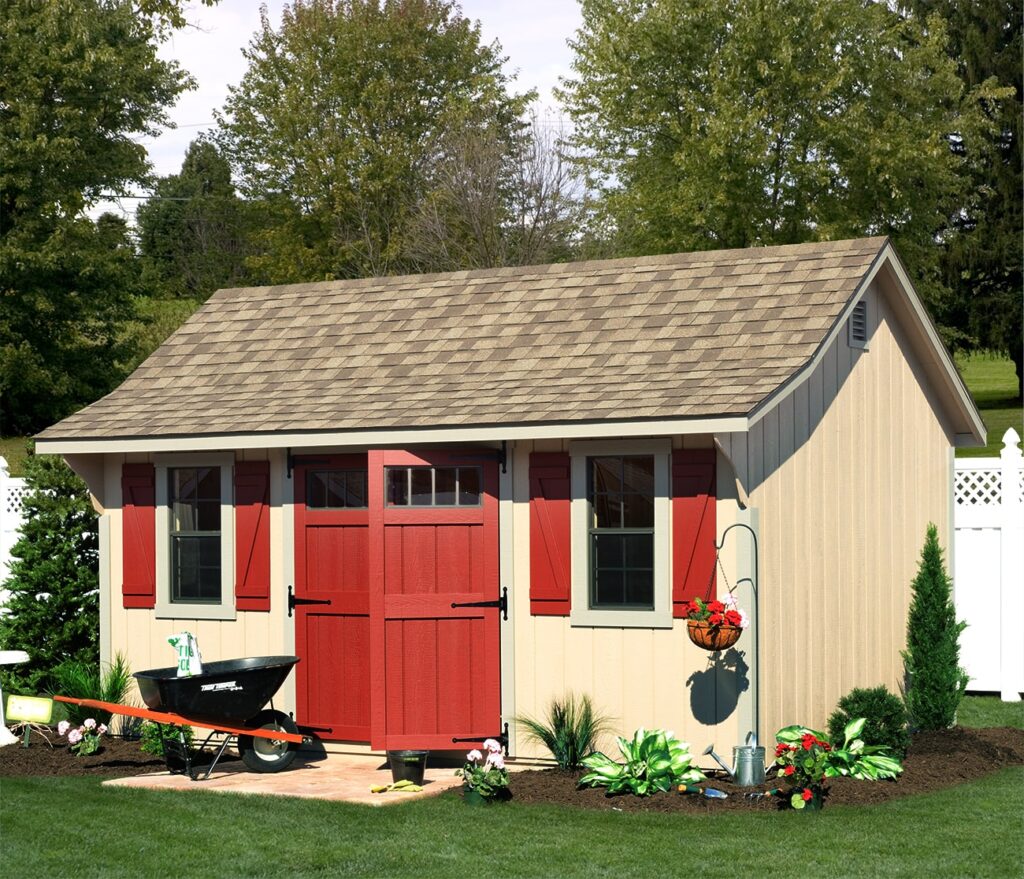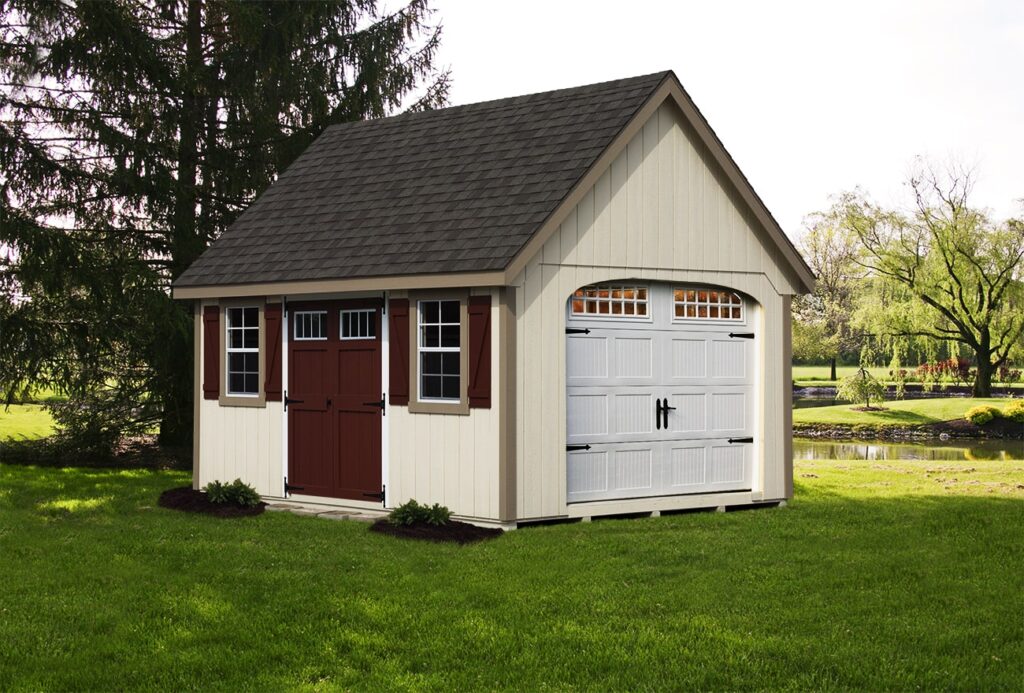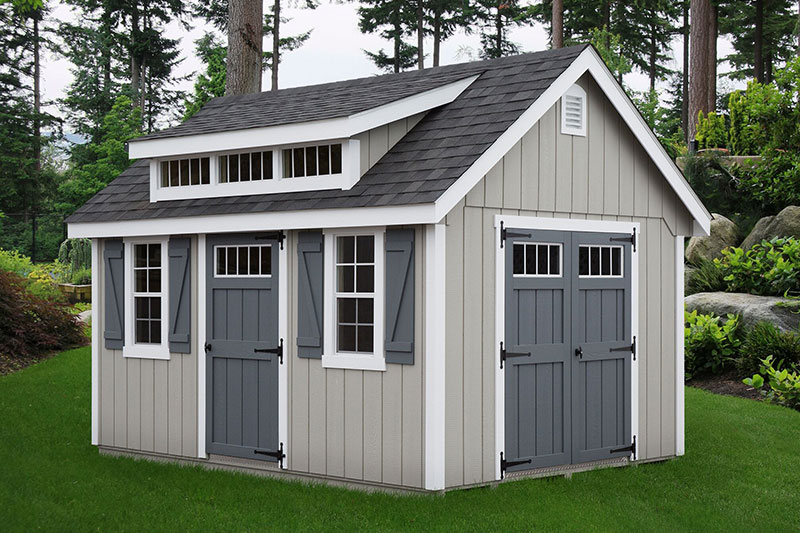
When making the decision to buy a shed, there are a lot of things to consider. What size is best? What materials are more durable? What style matches your home? And how can you prepare for your shed installation?
In our new shed buying guide, we answer all these questions and more so you’re confident with your decision to purchase a new outdoor structure.
Reasons to Buy a Shed
- Additional Storage. If your home or garage is bursting with tools, boxes, toys, and bins, a storage shed can help expand the space and allow for more organization in your home.
- Increase Curb Appeal. A well-designed shed can add visual appeal to your home and help your landscaping look put together. There are even customization options to match your shed to the rest of your home, but we’ll get to that later in this shed buying guide.
- Added Security. When backyard equipment, toys, or other items are out and easily accessible, your home becomes more interesting to potential intruders. A shed can help you not only keep these items organized but also secure, so your house is of less interest to people walking by.
Buying a Shed vs. Renting a Storage Unit
One of the first thoughts you may have if you need more storage is to rent out a separate unit rather than buying a shed. Oftentimes, this is the easy way to get items out of your home. However, this isn’t the most financially savvy choice.
On average, monthly costs for a storage unit can range between $75 to $300 depending on the size and location. These costs only include the physical space. You may also have additional fees for insurance, climate-control units, and taxes.
On the other hand, buying a shed has a larger initial cost but provides more long-term value. You’ll have full control over your storage space and everything is accessible from your backyard.
If you’re weary about the upfront costs of a shed, there are rent-to-own programs available. This allows you to pay smaller monthly payments until you pay off the entirety of the shed cost.
What Size Shed Do I Need?
The size you need will depend on the purpose of your shed. Ask yourself the following to help get an idea of what size is needed.
- What are the main tools, items, or pieces of equipment that I’ll be storing in the shed?
- Where will I put this shed, is the location conducive to the size I want?
- Are there any restrictions on what size shed I can have on my property?
Here are our general guidelines for storage shed sizes and what their best purpose is.
- 8’ x 10’ Sheds — Perfect size for a small yard.
- 10’ x 10’ Sheds — Suitable space for use as a gardening shed.
- 10’ x 20’ Sheds or 12’ x 24’ Sheds — Plenty of room available for a workshop.
- 14’ x 28’ Sheds — Easily accommodates riding lawn mowers or ATVs.
You also need to consider the additional space needed for your shed foundation.
- At least 1’ of space on all sides for your foundation.
- At least 3’ of space between your shed and any fencing or trees.
- Additional “setback” from property lines, roads, or floodplains that are regulated by your municipality.

Choosing a Shed Style
Now comes the exciting section of our shed buying guide! Choosing the right shed style is where you can truly customize your structure so it fits with the rest of your home. At Penn Dutch Structures we have a wide variety of designs and styles for you to choose from.
Some of our most popular shed styles include:
- Dutch Barn – A traditional barn look with a classic gambrel roof to add country style to your landscaping.
- Board & Batten – These sheds are made by altering wide boards and narrow strips to create a unique design.
- A-Frame – We have three different A-Frame styles including, our original A-Frame, A-Frame Elite, and A-Frame garden. The popular peak roof style is available for all choices but each style varies in size to serve different purposes.
- Quaker – A traditional shed style, the Quaker comes with a roof overhang and lots of overhead interior space to store taller items.
- Chalet – Also with a very high roof, Chalet sheds allow for a lot of storage space without overtaking your backyard space.
Shed Accessories and Customizations
At Penn Dutch Structures, we have a lot of standard designs that can be elevated with customizations. We can customize the following for your new shed.
- Building & Trim Color
- Windows, Doors & Garage Doors
- Vents
- Lofts
- Weathervanes
Aside from these customization options, there are also shed accessories for you to incorporate into your final design.
If your shed is holding large equipment or a riding mower, you can build a shed ramp to easily get in and out of your structure. You can decide to build the ramp yourself or buy a ramp from a home improvement store.
At the beginning of this shed buying guide, we highlighted that one benefit to a shed is higher security for your backyard items. You can further increase shed security by implementing physical locks, exterior lighting, and cameras surrounding the area.
You can also include shed accessories within your shed. Keep the interior of your shed organized by adding shelving, hooks, and bins.
Materials Used to Build Your Shed
As part of these customizations, you can choose different materials for your shed. Each comes with benefits and easy maintenance. The decision comes down to the style you’re looking for.
Shed Roof Materials
At Penn Dutch Structures, we use architectural shingles as our main roof material compared to 3-tab shingles. Architectural shingles provide more dimension and texture to your roof which ultimately provides a higher visual appeal.
Architectural shingles are thicker and more durable as well. In bad weather or severe storms, they’re less susceptible to warping, peeling, or buckling.
Wood vs. Vinyl Siding
Your exterior shed wall material options are wood or vinyl. Both are extremely durable options but there are some differences in terms of resistance, lifespan, and customizations.
All vinyl siding is naturally rot- and insect-resistant whereas there are only certain types of wood that are naturally resistant to rot and insects. Also, generally speaking, vinyl siding sheds are known to last a bit longer than wood siding.
Because of the way each shed is constructed, wooden sheds are generally cheaper than vinyl sheds. Just like anything else, the wooden sheds will require more maintenance down the line but have a lower upfront cost.
If you’re looking for a natural shed style, wood siding can provide that. Whereas vinyl siding can provide you with a pop of color in your landscaping. It truly depends on what backyard theme you’re looking for.

Preparing For a New Shed
Once you find the perfect shed for your home, it’s time to prepare for installation. There are two different ways you should prepare for your new shed.
First, by ensuring you’re following all of your HOA regulations. And second, by making sure the shed foundation is ready for our team to come install the structure.
Permits and Zoning Regulations
If you live in a residential community or a residential zone, you may be a part of a Homeowners Association. If you are, you likely have to follow a certain set of regulations when adding to your property.
Your HOA legislation could limit the size of your shed or a maximum height. These rules may also give guidance on where you can place your shed. Specifically, you can’t place your shed too close to the edge of your property line or the road.
It’s important to check your HOA’s committee process so you can submit the appropriate documentation to them. Some possible documents would be site plans, images of the shed and the dimensions, and a topographic map.
Building a Shed Foundation
The final step of our shed buying guide is how to prepare your site for installation. As we mentioned before, there are additional dimensions you have to consider for your shed foundation.
You’ll need to level out this foundation, either with gravel or concrete, and then install a retaining wall. Finally, when you’re ready for our team to install your shed, we’ll need a clear path to the shed foundation.
This blog was originally published on February 26th, 2019, and updated on December 1st, 2023.
Ready to Take Action with this Shed Buying Guide?
Browse our entire collection of shed styles and find your favorites. Each one comes with a 5-year warranty, delivery, and installation services.

